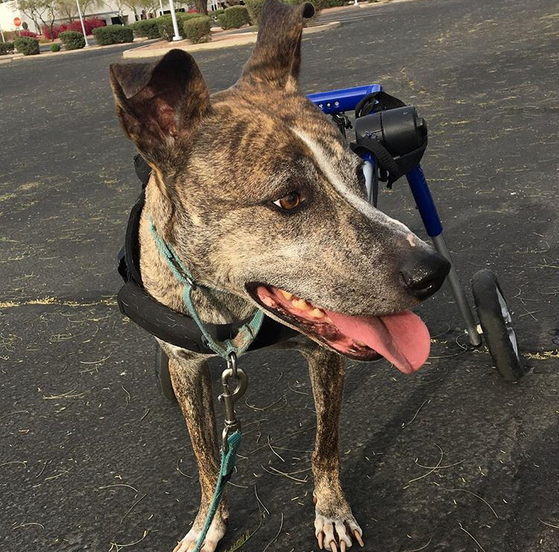|
6/25/2018 2 Comments BURTONToday we talk to Meredith who kindly shares her experience with her dog Burton. Meredith adopted Burton from the Arizona Animal Welfare League when he was about 6 months old. Burton became paralyzed during 2016 from a suspected Fibrocartilagenous Embolism (FCE). Meredith tells their story and offers some great tips on bladder management and keeping high energy dogs entertained. Could you tell us about Burton's condition?I will never forget March 6, 2016 when I woke for my normal morning walk with my three rescue dogs to find Burton paralyzed. It was completely unexpected and an incredibly scary experience not knowing what happened or if something could have been prevented.
Over two years later, Burton scoots around with his super strong front legs in the house and yard and also has a wheelchair for walking. He just recently hit 1.5 miles which is the furthest he has gone on a walk since his paralysis. Burton does not have any feeling midway down his back all the way to his backend. I have to help him pee by expressing his bladder and deal with the other business whenever and wherever it appears.
2 Comments
Today's interview comes from Portugal where we talk to the lovely Iris about life with her paralyzed, long haired, Miniature Dachshund called November Sky (or Sky to her friends). Sky first showed signs that she was struggling to walk in late October 2016. Iris initially suspected that Sky’s problems walking were associated with a cyst that had been found on her kidney earlier that year. Not long after Sky's condition became worse. One morning she was unable to get herself out of her crate herself into a sitting position. "We rushed her to the local vet, who told us it was her intervertebral disc disease (IVDD), and she needed six weeks crate rest. With luck she might walk again." Iris shares more of her story, including their daily routine. What is it like caring for a dog with IVDD?4/25/2018 9 Comments EDNAToday we speak with Kindel about life with Edna. Edna has cerebellar hypoplasia which is a congenital disorder in which the cerebellum (the part of the brain responsible for coordination) does not fully develop. In Edna's case her cerebellum is almost non-existent. Cerebellar hypoplasia in dogs is often not noticed at birth and only becomes apparent at around 6 weeks of age when they become more active. Dogs with this condition can appear uncoordinated and display jerky movements, or tremors. Edna is a great example of the fact that while there is no treatment for cerebellar hypoplasia dogs, with a little extra care they can often go on to live happy lives. Thanks to Kindle for sharing her experience and advice on how to care for a dog with cerebellar hypoplasia. Read on for Kindle’s recommended products to support cerebellar hypoplasia dogs, such as this playpen, harness and floor mats. If you have more advice to share please leave a comment below. What is a regular day like with Edna? |
Search or select topicsAll Acupuncture Arthritis Bladder Management Blindness Bowel Management Cerebellar Hypoplasia Deaf Degenerative Myelopathy Diabetes Diet Electro Stimulation FCE Genetic Disorder Grooming Hemivertebrae Hydrotherapy Incontinence IVDD Laser Therapy Limb Amputation Limb Deformity Paralysis Physical Therapy Rescue Spinal Injury |
Search by typing & pressing enter



